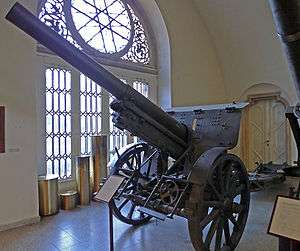10.4 cm Feldkanone M. 15
The 10.4 cm Feldkanone M. 15 was a heavy field gun used by Austria-Hungary in World War I. Guns captured or turned over to Italy as reparations after World War I were taken into Italian service as the Cannone da 105/32 and were bored out to 105 mm to fit Italian ammunition. It was one of the principal Italian long-range guns in World War II and saw service in North Africa and Russia. Those few guns that were captured from the Italians by the Germans after the Italian surrender in 1943 were designated as 10.5 cm Kanone 320(i). It doesn't seem to have seen service with any of the Austro-Hungarian successor states after World War I.
| 10.4 cm Feldkanone M. 15 | |
|---|---|
 10.4 cm Feldkanone M. 15 at the Heeresgeschichtliches Museum Wien. | |
| Type | Field gun |
| Place of origin | Austria-Hungary |
| Service history | |
| In service | 1916-1945 |
| Used by | |
| Wars | World War I World War II |
| Production history | |
| Designer | Skoda |
| Designed | 1909-1914 |
| Manufacturer | Skoda |
| Produced | 1914-1918 |
| No. built | 577? |
| Variants | Cannone da 105/32 |
| Specifications | |
| Mass | 3,030 kg (6,680 lb) |
| Barrel length | 3.64 m (11 ft 11 in) L/35 |
| Shell | Separate loading, cased charge and projectile 104 x 580mm R 16.1 kilograms (35 lb 8 oz)[1] |
| Caliber | 105 mm (4.13 in) |
| Carriage | box trail |
| Elevation | -10° to +30° |
| Traverse | 6° |
| Rate of fire | 3-4 rpm |
| Muzzle velocity | 668 m/s (2,191 ft/s) |
| Maximum firing range | 16,200 m (17,700 yd)[2] |
| Wikimedia Commons has media related to 10.4 cm Feldkanone M. 15. |
For transport it broke down into the customary two loads. And it carried the customary two seats on the gun shield for crewmen. All data given herein is for the Italian version of the gun.
Four guns were used by Poland during the Polish-Soviet war 1919-1920.[3]
A rusting 10.4 cm Skoda was found in the Presanella mountains in the year 2000, where it supposed it was dueling an Italian 149/23 during the First World War.[4][5] Found at 3171 meters altitude, the gun came completely out of the glacier in the very warm summer of 2003. Because it was located on a 45 degree slope, the risk of it sliding down was considered too great, so the gun was relocated by lifting it with a Superpuma helicopter.[6]
Notes
- "101". www.quarryhs.co.uk. Retrieved 2017-09-03.
- Chamberlain, Peter (1975). Light and medium field artillery. Gander, Terry. New York: Arco. p. 10. ISBN 0668038209. OCLC 2067331.
- Konstankiewicz, Andrzej (2003). Broń strzelecka i sprzęt artyleryjski formacji polskich i Wojska Polskiego w latach 1914-1939, Lublin. p. 53. ISBN 83-227-1944-2. (in Polish)
- "Il grande cannone della Presanella - di Mauro Zattera". Archived from the original on 2013-09-05. Retrieved 2013-09-05.
- Restauro Cannone Skoda 10.4, Museo Storico Italiano della Guerra, Provincia autonoma di Trento
- Il recupero del cannone 10.4 Skoda Archived 2012-09-06 at Archive.today, Museo della Guerra Bianca in Adamello
Bibliography
- Gander, Terry and Chamberlain, Peter. Weapons of the Third Reich: An Encyclopedic Survey of All Small Arms, Artillery and Special Weapons of the German Land Forces 1939-1945. New York: Doubleday, 1979 ISBN 0-385-15090-3
- Ortner, M. Christian. The Austro-Hungarian Artillery From 1867 to 1918: Technology, Organization, and Tactics. Vienna, Verlag Militaria, 2007 ISBN 978-3-902526-13-7